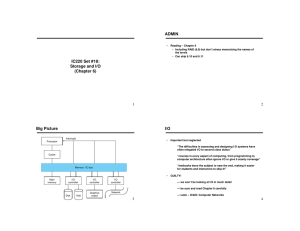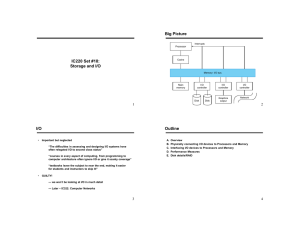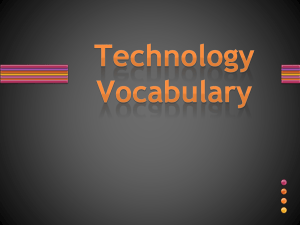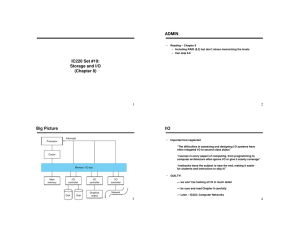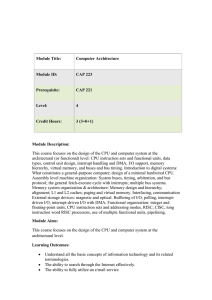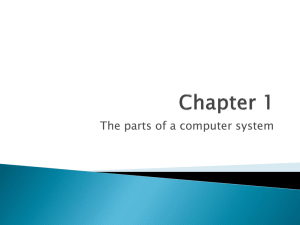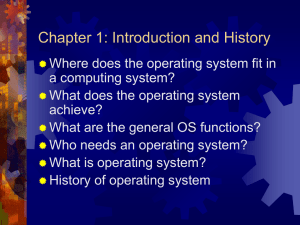Big Picture IC220 Set #11: Storage and I/O
advertisement
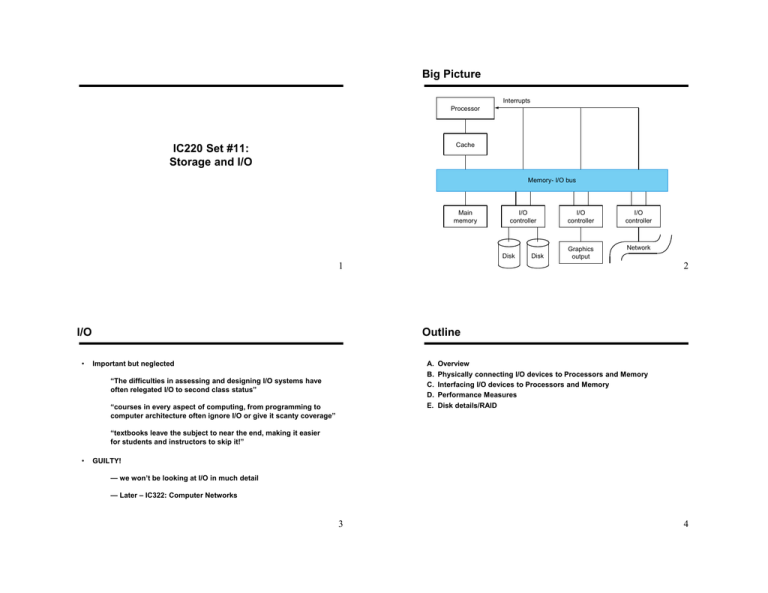
Big Picture Interrupts Processor Cache IC220 Set #11: Storage and I/O Memory- I/O bus Main memory I/O controller Disk Disk I/O controller I/O controller Graphics output Network 1 I/O • 2 Outline Important but neglected A. B. C. D. E. “The difficulties in assessing and designing I/O systems have often relegated I/O to second class status” “courses in every aspect of computing, from programming to computer architecture often ignore I/O or give it scanty coverage” Overview Physically connecting I/O devices to Processors and Memory Interfacing I/O devices to Processors and Memory Performance Measures Disk details/RAID “textbooks leave the subject to near the end, making it easier for students and instructors to skip it!” • GUILTY! — we won’t be looking at I/O in much detail — Later – IC322: Computer Networks 3 4 (A) I/O Overview • (B) Connecting the Processor, Memory, and other Devices Can characterize devices based on: 1. behavior Two general strategies: 1. Bus: ____________ communication link Advantages: CPU Mem Disk 2. partner (who is at the other end?) Disadvantages: 3. data rate • • 2. Point to Point Network: ____________ links Use switches to enable multiple connections Advantages: Performance factors: — access latency — throughput — connection between devices and the system — the memory hierarchy — the operating system Other issues: – Expandability, dependability CPU Mem Disk Disadvantages: 5 Typical x86 PC I/O System 6 (B) Bus Basics – Part 1 • • Types of buses: – Processor-memory • Short, high speed, fixed device types • custom design – I/O • lengthy, different devices • Standards-based e.g., USB, Firewire • Connect to proc-memory bus rather than directly to processor Only one pair of devices (sender & receiver) may use bus at a time – Bus _______________ decides who gets the bus next based on some ______________ strategy – May incorporate priority, round-robin aspects • Have two types of signals: – “Data” – data or address 7 – Control 8 I/O Bus Examples (B) Bus Basics – Part 2 Firewire USB 2.0 PCI Express Serial ATA Serial Attached SCSI Intended use External External Internal Internal External Devices per channel 63 127 1 1 4 Data width 4 2 2/lane 4 4 Peak bandwidth 50MB/s or 100MB/s 0.2MB/s, 1.5MB/s, or 60MB/s 250MB/s/lane 1×, 2×, 4×, 8×, 16×, 32× 300MB/s 300MB/s Hot pluggable Yes Yes Depends Yes Yes Max length 4.5m 5m 0.5m 1m 8m Standard IEEE 1394 USB Implementers Forum PCI-SIG SATA-IO INCITS TC T10 • Clocking scheme: 1. ____________________ Use a clock, signals change only on clock edge + Fast and small - All devices must operate at same rate - Requires bus to be short (due to clock skew) 2. ____________________ No clock, instead use “handshaking” + Longer buses possible + Accommodate wide range of device - more complex control 9 (C) Processor-to-device Communication Handshaking example – CPU read from memory ReadReq 10 How does CPU send information to a device? 1. Special I/O instructions x86: inb / outb 1 3 Data 2 2 4 How to control access to I/O device? 6 4 Ack 5 2. Use normal load/instructions to special addresses 7 DataRdy 1. 2. 3. 4. 5. 6. 7. CPU requests read Memory acknowledges, CPU deasserts request Memory sees change, deasserts Ack Memory provides data, asserts DataRdy CPU grabs data, asserts Ack Memory sees Ack, deasserts DataRdy CPU sees change, deasserts Ack Called ______________________ Load/store put onto bus Memory ignores them (outside its range) Address may encode both device ID and a command How to control access to I/O device? 11 12 (C) Device-to-processor communication DMA Issues How does device get data to the processor? 1. CPU periodically checks to see if device is ready: _________________ • CPU sends request, keep checking if done • Or just checks for new info (mouse, network) What could go wrong? Interrupts Processor Cache Memory- I/O bus 2. Device forces action by the processor when needed: _________________ • Like an unscheduled procedure call • Same as “exception” mechanism that handles TLB misses, divide by zero, etc. Main memory I/O controller Disk 3. DMA: • Device sends data directly to memory w/o CPU’s involvement • Interrupts CPU when transfer is complete Disk 13 (D) I/O’s impact on performance • Total time = CPU time + I/O time • Suppose our program is 90% CPU time, 10% I/O. If we improve CPU performance by 10x, but leave I/O unchanged, what will the new performance be? • • I/O controller I/O controller Graphics output Network 14 (D) Measuring I/O Performance • • • Latency? Throughput? Throughput with maximum latency? • Transaction processing benchmarks – TPC-C – TPC-H – TPC-W • File system / Web benchmarks – “Make” benchmark – SPECSFS – SPECWeb – SPECPower Old time = 100 seconds New time = 15 16 (E) Disk Drives (E) RAID Platters Tracks • _______________ ________________ _______________ ___________ • • • Idea: lots of cheap, smaller disks Small size and cost makes easier to add redundancy Multiple disks increases read/write bandwidth Platter Sectors Track • To access data: — seek: position head over the proper track (3 to 14 ms. avg.) — rotational latency: wait for desired sector (.5 / RPM) — transfer: grab the data (one or more sectors) 30 to 80 MB/sec 17 18 RAID RAID RAID 0 – “striping”, no redundancy RAID 4 – Block-interleaved parity RAID 1 – mirrored RAID 5 – Distributed Block-interleaved Parity 19 20 RAID Flash Storage – alternative to spinning hard disk RAID 10 – Striped mirrors • Key point – still need to do other backups (e.g. to tape) – Provides protection from limited number of disk failures – No protection from human failures! 21 Fallacies and Pitfalls • Fallacy: the rated mean time to failure of disks is 1,200,000 hours, so disks practically never fail. • Fallacy: magnetic disk storage is on its last legs, will be replaced. • Fallacy: A GB/sec bus can transfer 1 GB of data in 1 second. • Pitfall: Moving functions from the CPU to the I/O processor, expecting to improve performance without analysis. 23 • Nonvolatile semiconductor storage – 100× – 1000× faster than disk – Smaller, lower power, more robust – But more $/GB (between disk and DRAM) • Flash bits wears out after 1000’s of writes – Not suitable for direct RAM or disk replacement – Wear leveling: remap data to less used blocks – Result: “solid-state hard drive” 22
